Jefferson County, Colorado, and Nearby Counties:
Clear Creek, Gilpin and Summit
Sphingidae
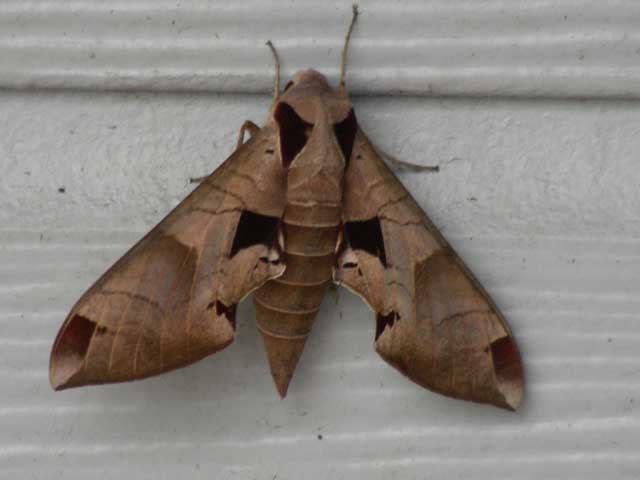
|
|
Inspired by and dedicated to Gail Youmans, July 2011; August 13, 2011 Updated as per James P. Tuttle's The Hawk Moths of North America, August 13, 2011 Updated as per BAMONA, August 13, 2011; July 30, 2022 Updated as per personal communication with Sue Hiegel (Eumorpha achemon, Littleton, June 27, 2012); June 30, 2012 Updated as per personal communication with Ashlee (Eumorpha achemon, Westminster, July 7, 2014); July 7, 2014 |

This page is inspired by and dedicated to Gail Youmans who sends the image of Eumorpha achemon at top of the page.
Gail writes, August 10, 2011, "Does seeing this moth mean anything for the winter moths? Will it be an early winter etc?"
I reply, "Hi Gail,
"I request permission to post your image of Eumorpha achemon, the Achemon Sphinx, to a Jefferson County thumbnail page that I will create??
"This is typical flight time for that species in Colorado. It does not indicate anything other than that you have breeding populations of
Eumorpha achemon in your area."
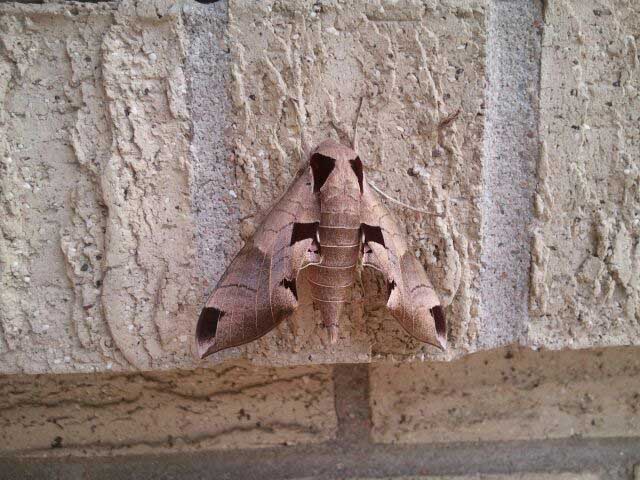
Eumorpha achemon, Littleton, Jefferson County, Colorado,
June 27, 2012, courtesy of Sue Hiegel.
A "WO" after the species name indicates that I (William Oehlke) expect that this moth is present or might be present, although unreported. A "Jefferson" indicates the moth is confirmed on BAMONA for Jefferson County.
Althhough theis page was created as a checklist from Jefferson County, it also serves as a valid checklist for the nearby counties of Clear Creek, Gilpin and Summit whose BAMONA confirmations are indicated below:
Jefferson: Ceratomia amyntor; Ceratomia catalpae; Ceratomia undulosa; Manduca sexta; Sphinx asellus; Sphinx chersis; Sphinx drupiferarum; Sphinx gordius, now replaced by oslari; Sphinx oslari; Sphinx perelegans; Sphinx vashti; Pachysphinx modesta; Pachysphinx occidentalis; Paonias excaecata; Paonias myops; Smerinthus jamaicensis; Eumorpha achemon; Hemaris diffinis; Hemaris thetis; Amphion floridensis; Hyles lineata; Proserpinus juanita;
Clear Creek: Manduca quinquemaculatus; Pachysphinx occidentalis; Smerinthus cerisyi; Hyles gallii; Hyles lineata;
Gilpin: Sphinx vashti;
Summit: Smerinthus cerisyi; Sphinx asellus; Hyles gallii; Hyles lineata;
Please help me develop this list with improved, documented accuracy by sending sightings (species, date, location), preferably with an electronic image, via email to Bill Oehlke.
Please also submit sightings to BAMONA, an excellent online resource, via link to left or top of page.
Eumorpha achemon is probably quite common in Jefferson County as four different people have sent images of that species as of July 7, 2014.
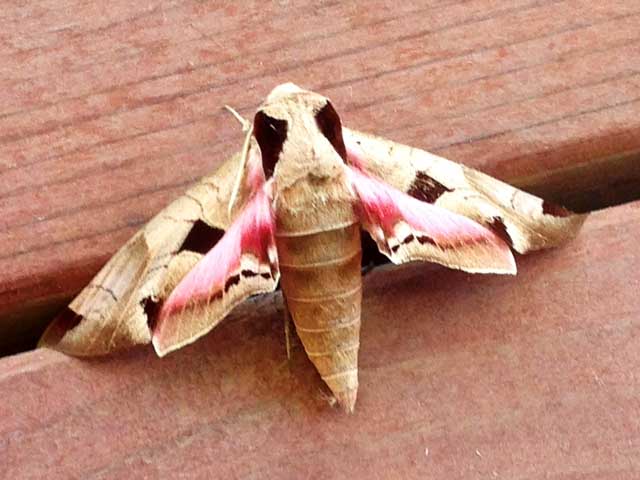
Eumorpha achemon, Westminster, Jefferson County, Colorado,
July 7, 2014, courtesy of Ashlee.
Sphinginae subfamily
Ceratomia catalpae Jefferson, as a stray or misidentified.
Sphinx perelegans BAMONA, probably confused with Sphinx vashti. I doubt Sphinx perelegans is present anywhere in Colorado.
Smerinthini Tribe:
Macroglossinae subfamilyDilophonotini tribe:
Philampelini tribe:
Eumorpha achemon, Lakewood, July 2011, courtesy of Gail Youmans. |
 | Amphion floridensis Jefferson, Nessus Sphinix: This day flier is widely distributed. If you have Virginia Creeper, you probably have the Nessus Sphinx. Two bright, distinct, narrow yellow bands are often visible on the abdomen. |
 | Darapsa myron WO, Virginia Creeper Sphinx; Grapevine Sphinx: Forewing dark brown to pale yellowish gray, with olive tint, sometimes quite green. On costal margin there is dark rectangular patch, although this may be reduced or absent. Hindwing is pale orange. |
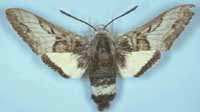 | Euproserpinus wiesti WO, Prairie Sphinx or Wiest's Primrose Sphinx: Black body with white band on abdomen. FW upperside gray-brown; median area has black lines and gray band; underside white with black o. m.. Hw upperside yellowish white with narrow black o. m., black at base. |
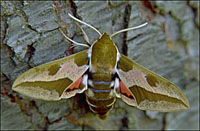 |
Hyles euphorbiae
WO, the Spurge Hawk Moth |
 | Hyles gallii WO/Clear Creek/Summit, Bedstraw Hawk Moth or Gallium Sphinx: Some years I see them on P.E.I., some years, I do not. |
 | Hyles lineata Jefferson/Clear Creek/Summit, White-lined Sphinx: Fw dark olive brown with paler brown along costa and outer margin, a narrow tan band running from the wing tip to the base, and white streaks along the veins. The hindwing upperside is black with a reddish pink median band. |
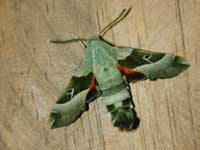 | Proserpinus juanita Jefferson, the Juanita Sphinx: The upperside of the forewing is pale gray-green with a deep green-brown median area and a white dash at the wing tip. |
Enjoy some of nature's wonderments, giant silk moth cocoons. These cocoons are for sale winter and fall. Beautiful Saturniidae moths will emerge the following spring and summer. Read Actias luna rearing article. Additional online help available.
Eggs of many North American species are offered during the spring and summer. Occasionally summer Actias luna and summer Antheraea polyphemus cocoons are available. Shipping to US destinations is done from with in the US.
Use your browser "Back" button to return to the previous page.
This page is brought to you by Bill Oehlke and the WLSS. Pages are on space rented from Bizland. If you would like to become a "Patron of the Sphingidae Site", contact Bill.
Please send sightings/images to Bill. I will do my best to respond to requests for identification help.
 Show appreciation for this site by clicking on flashing butterfly to the left. The link will take you to a page with links to many insect sites. |